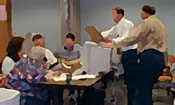

Chapter 13 - Invention:
Adapting and Innovating to Match the School Site Context and Reality
For several decades now we have suffered as a profession from the delusion that good programs can be imported and implanted. Countless well meaning staff developers, teachers and administrators have attended workshops in promising practices and returned to show the rest of the district how to make the innovation work.Unfortunately, this implantation or transplantation strategy ignores a great deal of what we know about change and the change process. The consequence has been wave after wave of bandwagons and trainwrecks. Teachers nod their heads knowingly as the list is read. They arrive with sound and fury promising everything only to be themselves replaced by some new fad within a year or two. We rarely pass much beyond the awareness stage, let alone reach the consolidation stage.
Successful innovation will require invention and construction at the school level. Instead of thinking of innovations as transplants, it might make better sense to think of them as unfinished jigsaw puzzles or block sets. The new programs with the greatest chance of long term survival and student success will be those put together by the people who will implement them
One of the prime jobs of school councils is to take the promising pieces of programs that have worked elsewhere and adjust, modify and rearrange them to fit school circumstances. Fundamental to the success of this invention process is a careful appraisal of the school's present condition.
What are the key resources available? What are the characteristics of the teaching staff? What can the council reasonably expect of them? What is their level of readiness for the kinds of programs and strategies being considered?
What do the children bring to the classroom as strengths or as problems? What special needs do they have?
Planting the seeds of a new program is not unlike planting a real garden. The soil must be prepared. The conditions must be right. The school council must do the cultivating, the loosening up of the soil.
A basic dilemma facing the team is its need to exercise leadership even in the face of considerable inexperience with whatever innovations are being considered. Once an innovation is fully consolidated, teachers may exhibit a level of skill which Joyce calls "executive control," but that may require 2-3 years. Site-based management puts a relatively inexperienced group in the role of planning something of which they have little knowledge. This is invention without expertise.
Perhaps it helps to maintain the gardening metaphor. Once planted a vegetable or flower garden may not be left alone to grow by itself, and yet this has been the practice with many implantation schemes. A few days of introductory staff development and "You're on your own."
School councils might investigate ways to weed their gardens and "nip problems in the bud." Sometimes a garden grows best when the gardener does some pruning. It is the same way with school programs. They must be adjusted and modified along the way. Weeds will grow. Insects and birds will arrive unexpectedly. There may be long periods of drought. The sun may beat down unmercifully. There may even be floods. The school council is ever watchful, tending this garden so that it will flower and mature.
Copyrighted 1991 by Jamie McKenzie, all rights reserved.